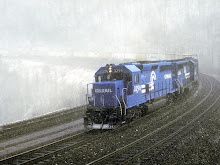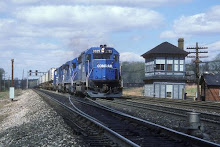Well, this is going to have to be group effort, and I know there may be willing participants spread around the world, and it would be a real shame to only be able to use our finely crafted modules when we all get together.
NTRAK's standards allow for three or four tracks, which is perfect for the area we intend to model. NTRAK has also created time tested standards and practices for many of the potential headaches we might run into (module construction, wiring, etc...).
The NTRAK standards do have two notable drawbacks:
- Track - The NTRAK standards require the use of horrendously ugly code 80 track. This stuff is and looks dated, however, given the grand scale of what we will be building, some time spent properly painting, weathering and ballasting it will hopefully mitigate some of its offensive aesthetics.
- Track spacing - The NTRAK standard specifies 1.5" centerlines for the mainlines. This is wider than the prototype. There is no real fix for this, except when you consider that the mainline itself was originally 4 tracks wide, and even though most of it has been shrunken down to 3 tracks, the track that was removed was in the middle, meaning that the width of the roadbed will be about right. This makes the track spacing a lot less offensive than if we were building a double track line.
There are some really compelling reasons to be part of the NTRAK fold.
- Large Events - The time to really pull all of this together for that "wow" moment is at a large show. These events almost always have a large NTRAK presence, and it makes it much easier to gain access to them by being part of the group.
- Expertise - It's a lot easier to do something that's a variation on an existing theme. NTRAK has largely solved many of the potential problems that we'll encounter, and it's far easier to enlist help when you're part of the group.
- Audience - There are a huge number of NTRAK members, and it's far easier to enlist their support, pique their interest, and get them involved if you're already part of a group that they are too.





I will grudgingly succumb to these mind numbing standards, but only as a means to not bog the project down in its gestational phase.
ReplyDeleteI would personally rather pursue excellence and craftsmanship and use the best products available for what has the potential to be a landmark project. I believe using the Ntrak track standards in particular will make this just another bunch of N track modules.
I do see the benefit of using the standards, though in terms of flexibility, and even visibility. I would be able to "store" mine at my club by keeping it installed in their modular layout, which would save a lot of space in my garage!
But still, why not push the envelope a little here, and maybe get N track to sit up and take notice that new products can be applied to improve the old favorite...
Lee
I agree Lee. I think that maybe we should really push it. In fact, as much work as it might be, I think this is JUST the time to figure out how to make C55 backwards compatible on the large scale...
ReplyDeleteI know I've had good luck in running a file along inside the rail, but never tried anything with turnouts.
Code 80 is not an NTRAK standard. I and others have built many NTRAK modules with code 55 Peco and ME track. Atlas code 55 does have problems with bigger flanges.
ReplyDeleteLikewise with track spacing. If you build a dedicated set it is not hard to drop to 1.25 inch spacing.
It's funny, I almost always lump PECO 55 in with Code 80 stuff because it looks so similar. The rail height is better, but it's still ugly!
ReplyDeleteBut like I said, I'm not going to let myself get caught up on track on this project, because it really IS about the "scene".
As noted elsewhere, the issue isn't 1.25" vs. 1.5" spacing... it's shifting track 4 out to 2.5" from track 2 to represent the dearly departed track 3! (Removed in the mid 1980's by Conrail as a cost savings measure).
ReplyDeleteI believe this is a critical visual element that shouldn't be compromised. It effects not only the look, but the dimensions of any element along the right of way, from signal bridges to highway overpasses, to culverts!
Transitions to accommodate a standard installation can easily be added by the individuals who wish to display their module outside the set.
I think, because of the odd spacing, we don't have to move anything too far to achieve "the look". Move the center track .25" toward and it may get the effect we need. Maybe move the other outer track .25" too.
ReplyDeleteI think I need to head down to the lab and do some experiments...
ReplyDeleteBut track is part of the scene. How many times have you looked at some impecable modelling and saw those GLARING PECO turnouts that ruin the mental image.
ReplyDelete5" Spacing track made of PECO C55 flex handles both the C80 transition and that pesky problem of 1.5 to 1.25 transition. Center track equals center line.
If we make modules to our own standards that ultimately acheive the end result of NTRAK standards we can't really go wrong.
Except that then, they won't be NTRAK modules any longer, and therefore we can't tie in with or leverage the NTRAK community. Not being able to do that is s a deal breaker for me, actually.
ReplyDelete